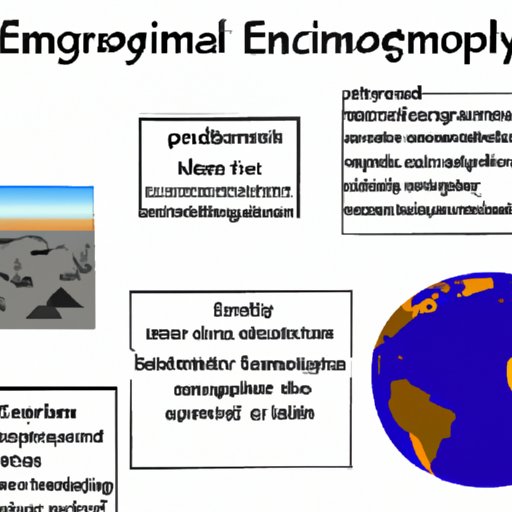Introduction
Earth science is the study of our planet – its land, atmosphere, oceans, and biosphere. It is a multidisciplinary field that incorporates aspects of geology, biology, chemistry, physics, and even mathematics to understand Earth’s dynamic systems. It also investigates the impact of human activities on our planet’s environment and how these activities shape Earth’s future. This article will explore the interconnectedness of Earth Science with other sciences, unpack the impact of human activity on Earth’s systems, and look at the role of Earth Science in society.
Exploring the Basics of Earth Science
So what is Earth Science? According to the American Geological Institute (AGI), Earth Science is “the study of the origin, history, and structure of the Earth; the processes that act on and shape it; and the distribution of life forms on it.” It is an interdisciplinary field that uses data from many different sources to form a comprehensive understanding of our planet.
The AGI breaks down Earth Science into four main branches: geology, oceanography, meteorology, and astronomy. Geology is the study of Earth’s materials, structures, processes, and the history of its formation. Oceanography focuses on the properties and behavior of oceans and the various organisms that inhabit them. Meteorology is the study of Earth’s atmosphere and climate, while astronomy examines the physical universe beyond Earth’s atmosphere. Each of these branches has its own areas of focus, but they are all interconnected and contribute to our overall understanding of Earth.
Earth Science also investigates Earth’s dynamic systems, such as the hydrologic cycle, the carbon cycle, and the nitrogen cycle. These cycles involve the exchange of energy, matter, and nutrients between the atmosphere, land, and oceans. They are essential for sustaining life on our planet and are influenced by both natural and human-induced changes.

Unpacking the Interconnectedness of Earth Science and Other Sciences
Earth Science is closely intertwined with other scientific disciplines, such as geology, biology, chemistry, and physics. Geology is the study of Earth’s materials, structures, and processes, and it provides the foundation for understanding Earth’s history and evolution. Biology examines the interactions between living organisms and their environments, while chemistry investigates the composition and properties of substances. Physics studies the behavior of matter and energy, and it is used to explain phenomena such as gravity, magnetism, and nuclear reactions.
These disciplines are all connected, and they complement each other in understanding Earth’s complex systems. For example, geology helps us understand how Earth’s surface features were formed, while biology helps us understand how species evolved and adapted over time. Chemistry and physics provide insight into the chemical and physical processes that drive Earth’s climate and weather patterns. Together, these disciplines allow us to gain a better understanding of our planet and its place in the Universe.
Examining the Impact of Human Activity on Earth’s Systems
Human activities have had a profound impact on Earth’s environment and its climate. The burning of fossil fuels has led to an increase in atmospheric carbon dioxide levels, resulting in global warming and climate change. Human activity has also led to increased levels of air and water pollution, which can degrade natural resources and threaten biodiversity. Deforestation and other land-use changes have further impacted ecosystems, leading to species extinction and loss of habitat.
These human-induced changes can have far-reaching consequences. For example, rising temperatures can lead to more extreme weather events, such as floods, hurricanes, and droughts. Warmer waters can also cause coral bleaching and other disruptions to marine ecosystems. Changes in the atmosphere can also affect air quality, leading to an increase in respiratory illnesses. In addition, deforestation and other land-use changes can lead to soil erosion and desertification.

A Closer Look at the Role of Earth Science in Society
Earth Science research has numerous benefits for society. It can help us better understand and predict natural disasters and other environmental changes, allowing us to prepare for and mitigate their impacts. It can also help us develop strategies for sustainable development and resource management. Earth Science research can also provide insight into the long-term effects of human activities on our planet and its environment.
However, there are also challenges facing Earth scientists. Many of these challenges stem from limited access to data and resources. In addition, Earth Science is often underfunded and undervalued in comparison to other fields, making it difficult for researchers to pursue their work. Lastly, public engagement in Earth Science can be limited due to a lack of knowledge about the field and its importance in society.
Despite these challenges, there are still opportunities for individuals to engage in Earth Science. From volunteering with local conservation organizations to participating in citizen science projects, there are many ways to get involved in the field. Additionally, people can support Earth Science research by donating to organizations that fund research, engaging in public outreach efforts, and advocating for policies that promote sustainability and resilience.
Conclusion
Earth Science is a broad and interdisciplinary field that seeks to understand our planet and its environment. It is closely connected to other scientific disciplines such as geology, biology, chemistry, and physics, and it investigates the impact of human activity on Earth’s systems. Finally, Earth Science plays an important role in society, providing insights into natural disasters, sustainable development, and resource management.
Understanding Earth Science is essential for protecting our planet and ensuring its future. By gaining a better understanding of Earth’s dynamic systems and the effects of human activity, we can make informed decisions about how to best manage our planet and ensure a sustainable future for all of its inhabitants.
(Note: Is this article not meeting your expectations? Do you have knowledge or insights to share? Unlock new opportunities and expand your reach by joining our authors team. Click Registration to join us and share your expertise with our readers.)
